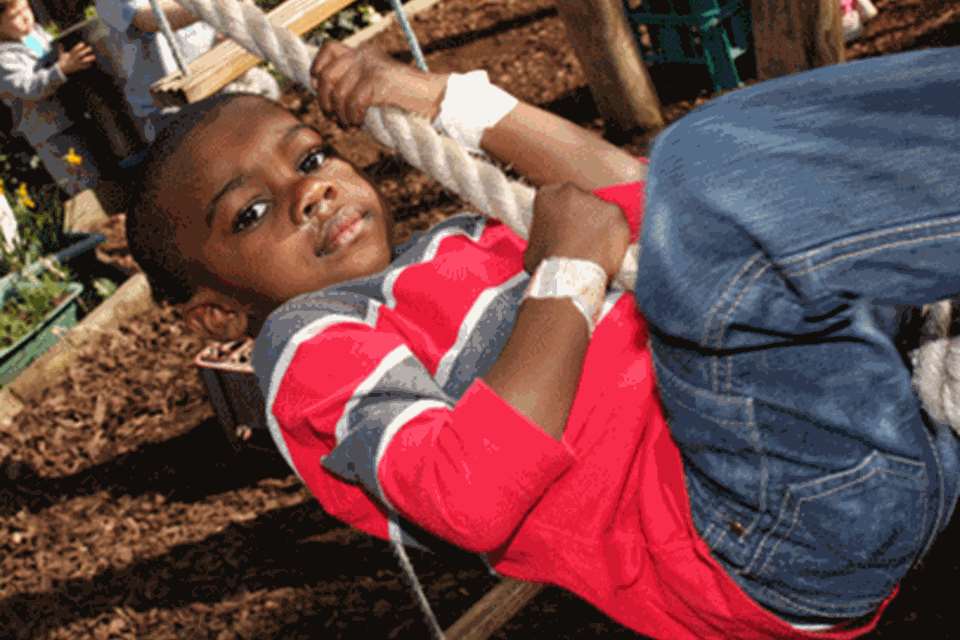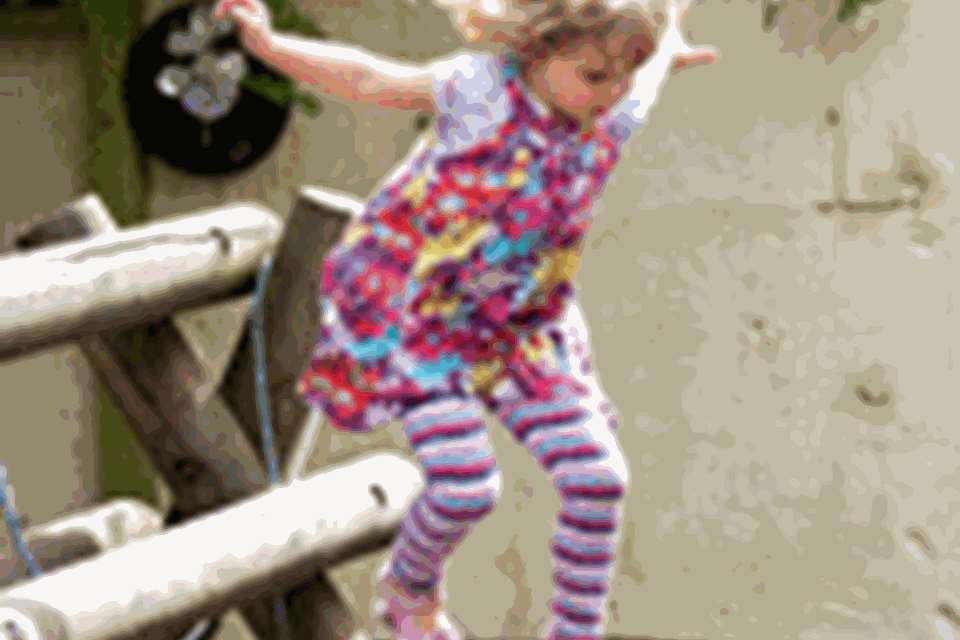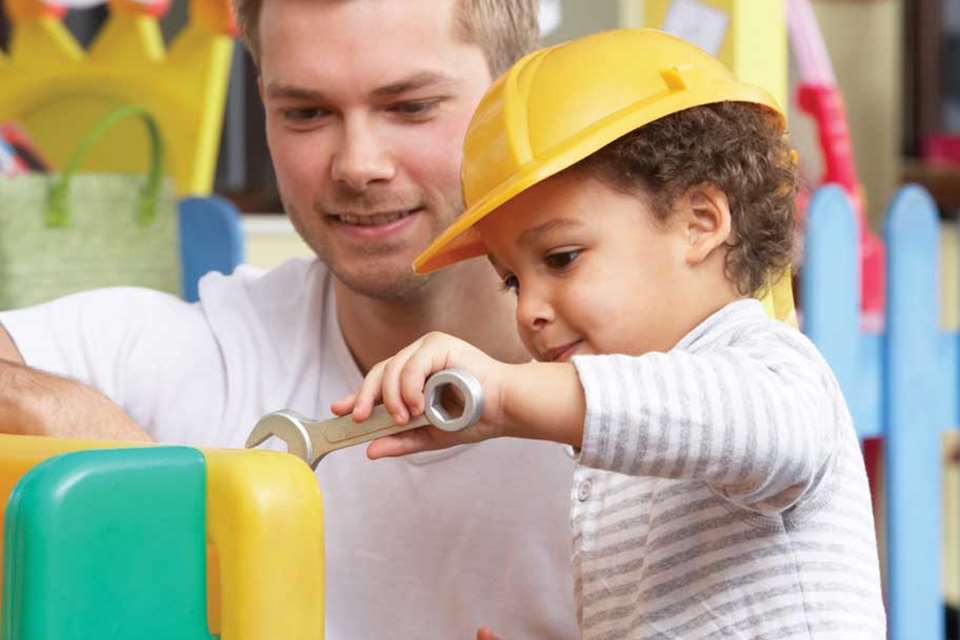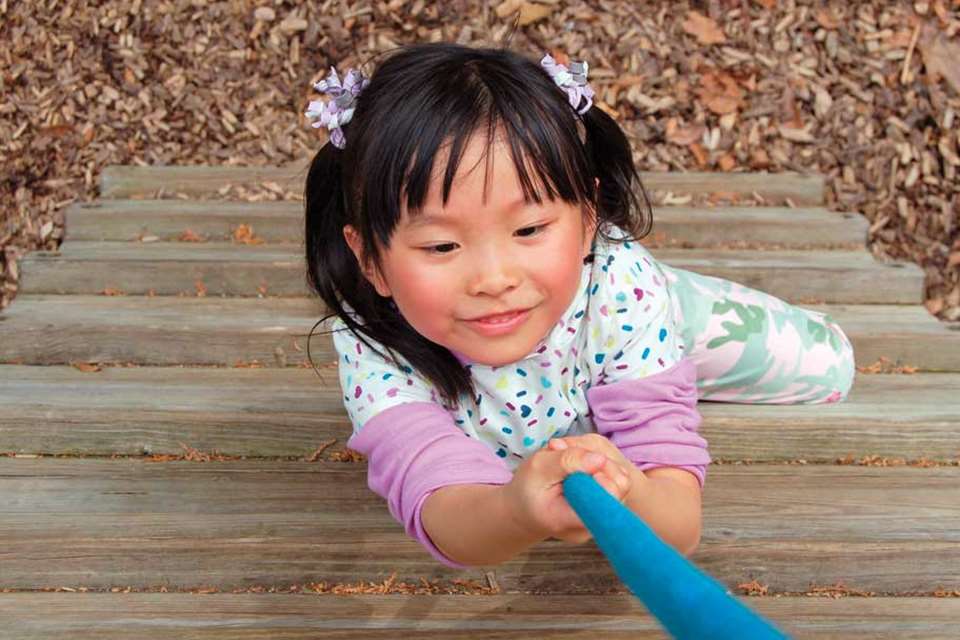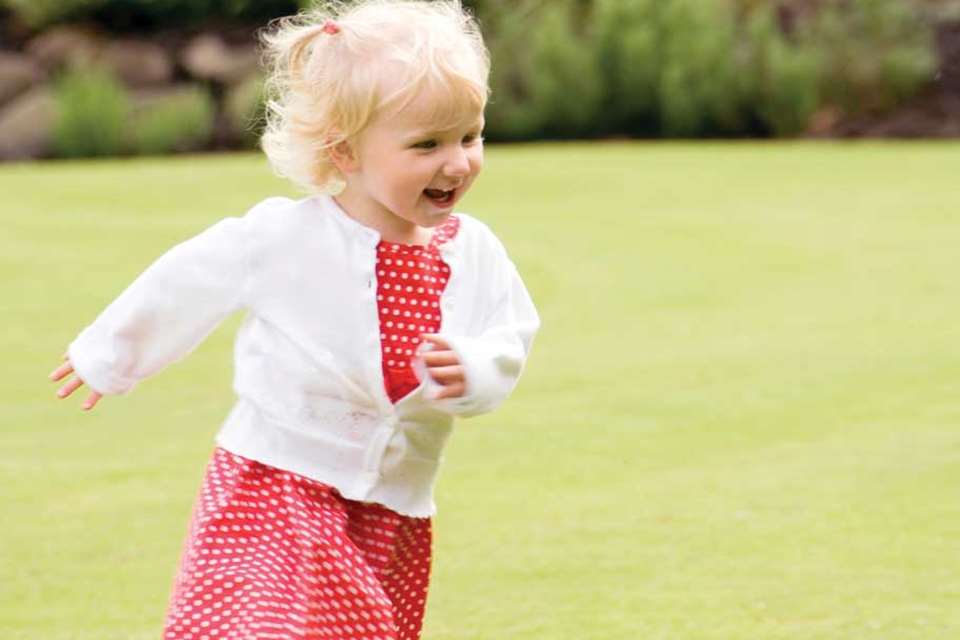Enabling Environments: Post-walking skills - On the hop
Lala Manners
Monday, August 11, 2014
Hopping and skipping are challenging skills to master. Here, Dr Lala Manners looks at how they emerge and offers ideas for supporting their development.

Hopping and skipping are useful - though not essential - locomotor skills. More complex and physically challenging to perform well than either walking or running, they nevertheless form the basic moves for many folk dances and playground games and are an integral component of a range of racket sports and martial arts.
Hopping is the first of the two skills to emerge. Generally, by 40 months children can hop once on their preferred leg. By 60 months, they can perform ten continuous hops and may also be able to travel forwards by 2-3 metres.
Hopping is a physically demanding action because the same leg must be used for take-off and landing. Significant strength, balance, co-ordination and timing is essential if the action is to be performed successfully.
Early hopping action will be kept close to the ground without the arms being used to assist balance in any productive way. In a mature hopping action, the body will remain relatively upright and the arms will be used to assist the optimum posture; this may be observed later in the dodging action required in many sports.
Skipping emerges at about 43 months, and by 60 months it has become a reasonably fluent action for most children. Interestingly, at 5.6 years 91 per cent of girls will be competent skippers, compared to 55 per cent of boys. The reasons for this disparity are unclear, but perhaps lie in personal preference or the opportunities afforded to girls to rehearse and refine this skill in dance classes they attend.
Skipping is basically a step-hop followed by another step-hop. Early skipping action may look a little 'wild and woolly', with the children taking wide steps and arms flailing. As they practise this skill, the body will be held more upright, steps will become smaller and neater and arms will become more co-ordinated with legs.
Skipping is rarely used as a means to travel at speed. It is simply impossible to move fast with the body held so upright. For this reason, the form of the action - how it looks - is more important than velocity; in a skipping race, all are equal.
Hopping and skipping are useful skills for children to have in their 'movement bank'. As speed is not an issue there is no element of competition involved in their rehearsal and refinement, so they can be practised safely in enclosed spaces.
For children to become competent and confident hoppers and skippers, it is useful to highlight underpinning skills. When space and time are limited, work on these independently
STRENGTH
If a mature action for hopping and skipping is to be achieved, a high level of lower body strength is needed -particularly in the thighs and bottom to effect lift-off and keep knees high. The muscles around the ankle joints must be strong to ensure stability.
Upper body strength in the torso and arms is also required to effect optimum posture for the flight action and ensure good balance. This is particularly important to avoid accidents when steering clear of people or obstacles at speed.
Use a clear wall to focus on overall body strength and to help with balance, and ask children to:
- - stand with their backs against the wall, and slide all the way down until their bottoms touch the floor, keeping their arms straight in front.
- - push up the wall and stand on tiptoes with hands high above heads, repeat and change speed - this will be challenging and very strengthening.
- - turn sideways and place one hand on the wall; stay on tiptoes and sit on heels; push up and balance; take hand off the wall when possible; take one foot off the floor; repeat on other side.
BALANCE
Balance is possibly the most critical component to consider when providing opportunities for children to refine hopping and skipping skills - they need to be able to keep their bodies upright while their legs are moving.
Use chairs or tables to help with balance and get children to place hands flat on a table or hold the back of a chair. Ask them to:
- - shift weight from one foot to the other, slowly at first then speeding up. Ensure the body does not tip from side to side too much.
- - bend knees then push up very fast onto tiptoes; let go of the chair or table and balance for a count of three; repeat this activity but lift one knee then the other while balancing.
There are many different variations of this activity - the combination of strength and balance is particularly important for hopping and skipping - so let children explore and submit their own ideas.
TIMING AND RHYTHM
The rhythms of hopping and skipping is one reason that they emerge late as travelling skills. The rhythms involved are not generic and many children will come from cultures where they are never used, either in music or dance.
Take time to clap or sound out different rhythms.
- - Hopping This is an even 1-2-1-2 rhythm. Tap 1-2 with one hand on a hard surface or floor, then 1-2 with the other hand. Make it fluent, 'bouncy' and at a speed that the children can hop at. Have the children repeat the same exercise with their feet.
- - Skipping This is a more difficult 1-2 rhythm with the accent on the 2 (lift-off). Call and clap the rhythm 'And up; and up; and up'. Clap this rhythm whenever you have the opportunity so the children become familiar with the sound and 'up' component that skipping demands. Ensure they clap this rhythm at a speed that matches the action that follows.
SPATIAL AWARENESS
The reason that hopping is integral to a range of ball and racket sports and martial arts disciplines is because effective dodging around an opponent or managing apparatus is a requirement for scoring, or flooring.
Skipping is a major component of many forms of folk dance in which floor patterns may be extremely complex and challenging to remember. Moving in a large group and working with partners demands a high level of spatial awareness and sensitivity - particularly if age and ability is mixed.
- - Place chairs in a slalom formation and walk and move around the chairs.
- - Change the chairs to a scatter formation, and walk and move around without bumping into anyone.
- - Have two children moving while the others wait their turn then change places quite quickly.
- - Place chairs in two lines facing each other and have two children at a time changing places.
MUSIC
Music is an invaluable aid to promoting hopping and skipping skills. English or Scottish country dance music is useful; also try American country and Western. Ballet music, particularly rehearsal or class recordings, is also good to work with, but just be careful of the speed and check that the rhythm is correct.
SEQUENCES
When children have the strength and balance to hop and skip with good form and enjoyment, begin to develop short sequences of movements that they can remember and repeat.
Choose a few basic dance combinations - skips, claps, hops, balancing - that may be organised and performed in a circle or straight lines. Everyone can join in and you could invite parents and carers to learn the combinations and move with the children in a group.
REMEMBER ...
Remember the underpinning skills necessary to achieve optimum form, and the different rhythms that accompany hopping and skipping. Mastering these skills will extend the possibilities for engagement in more organised physical activities as children mature.
Highlighting these skills will undoubtedly develop co-ordination and control, and the ability to negotiate small and large spaces. As strength and balance increase, so too will children's ability to adjust speed and direction purposefully.
Dr Lala Manners is director of Active Matters, www.activematters.org
MORE INFORMATION
- - Early Movers resource pack G609, British Heart Foundation, www.bhf.org.uk/publications/view-publication.aspx?ps=1002163
- - Early Years Movement Skills by Mary Chambers and David Sugden
- - Experiences in Movement and Music (5th Edition) by Rae Pica
- - Physical Development by Linda Cooper and Jonathan Doherty,
- - Supporting Physical Development and Physical Education in the Early Years by Jonathan Doherty and Richard Bailey.
[asset_library_tag 521,Download the PDF]


